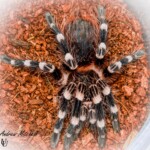Tarantulas for sale
Tarantulas comprise a group of large and often hairy spiders of the family Theraphosidae.
Other Spiders are for sale HERE.
-

Brazilian Red & White Tarantula – Nhandu chromatus (~2m)
£10.00 Add to cart -

Brazilian Salmon Pink Birdeater – Lasiodora parahybana (~2-3cm)
£10.00 Add to cart -

Brazilian Whiteknee tarantula Acanthoscurria geniculata (~4-5cm)
£20.00 Add to cart -

Ceratogyrus darlingi (Rear Horned Baboon Tarantula) (~2cm)
£8.00 Add to cart -

Grammostola pulchripes (Chaco golden knee) (~1cm)
£10.00 Add to cart -

Kochiana brunnipes (Dwarf Pink Leg) (~4-5cm)
£20.00 Add to cart -

Psalmopoeus victori (Mexican Half & Half) (~2cm)
£30.00 Add to cart -

Venezuelan suntiger tarantula Psalmopoeus irminia (~2-3cm)
£10.00 Add to cart
Ref: National Geographic
Tarantulas give some people the creeps because of their large, hairy bodies and legs. But these spiders are harmless to humans (except for a painful bite), and their mild venom is weaker than a typical bee’s. Among arachnid enthusiasts, these spiders have become popular pets.
Molting
Tarantulas periodically shed their external skeletons in a process called molting. In the process, they also replace internal organs, such as female genitalia and stomach lining, and even regrow lost appendages.
Habitat
There are hundreds of tarantula species found in most of the world’s tropical, subtropical, and arid regions. They vary in colour and behaviour according to their specific environments. Generally, however, tarantulas are burrowers that live in the ground.
Hunting
Tarantulas are slow and deliberate movers, but accomplished nocturnal predators. Insects are their main prey, but they also target bigger game, including frogs, toads, and mice. The South American bird-eating spider, as it name suggests, is even able to prey upon small birds.
A tarantula doesn’t use a web to ensnare prey, though it may spin a trip wire to signal an alert when something approaches its burrow. These spiders grab with their appendages, inject paralyzing venom, and dispatch their unfortunate victims with their fangs. They also secrete digestive enzymes to liquefy their victims’ bodies so that they can suck them up through their straw-like mouth openings. After a large meal, the tarantula may not need to eat for a month.
Natural Threats
Tarantulas have few natural enemies, but parasitic pepsis wasps are a formidable exception. Such a wasp will paralyze a tarantula with its sting and lay its eggs on the spider’s body. When the eggs hatch, wasp larvae gorge themselves on the still living tarantula.
Reproduction
The tarantula’s own mating ritual begins when the male spins a web and deposits sperm on its surface. He copulates by using his pedipalps (short, leglike appendages located near the mouth) and then scuttles away if he can—females sometimes eat their mates.
Females seal both eggs and sperm in a cocoon and guard it for six to nine weeks, when some 500 to 1,000 tarantulas hatch.
from Wikipedia –
Tarantulas comprise a group of large and often hairy spiders of the family Theraphosidae. As of August 2022, 1,040 species have been identified, with 156 genera. The term “tarantula” is usually used to describe members of the family Theraphosidae, although many other members of the same infraorder (Mygalomorphae) are commonly referred to as “tarantulas” or “false tarantulas”. Some of the more common species have become popular in the exotic pet trade. Many New World species kept as pets have setae known as urticating hairs that can cause irritation to the skin, and in extreme cases, cause damage to the eyes.
Like all arthropods, the tarantula is an invertebrate that relies on an exoskeleton for muscular support. Like other Arachnida, a tarantula’s body comprises two main parts, the prosoma (or cephalothorax) and the opisthosoma (or abdomen). The prosoma and opisthosoma are connected by the pedicel, or pregenital somite. This waist-like connecting piece is actually part of the prosoma and gives the opisthosoma a wide range of motion relative to the prosoma.



